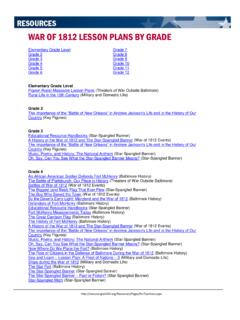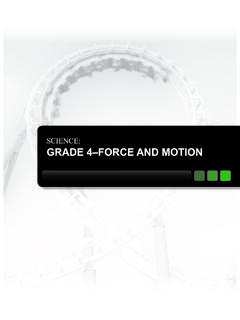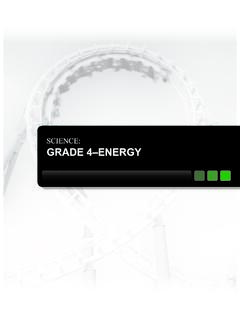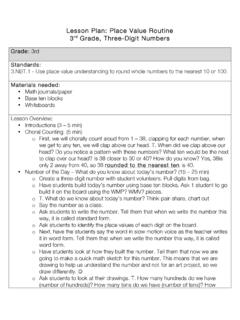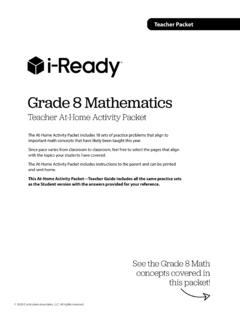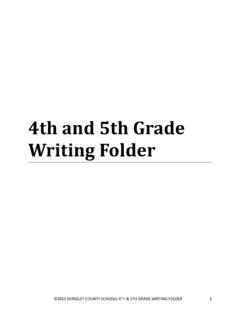Transcription of Perimeter and Area a Mathematics Unit for Grade 4
1 This unit plan provides a good example of how a variety of instructional strategies can be used to differentiate instruction throughout a unit. Differentiation on the basis of readiness, interest and learning profile are evident through the use of tiered activities, interest-based activities selected by the students, and projects geared to learning preferences. The availability of anchor activities at different readiness levels will ensure that students have a task to independently work on if they complete an activity before other members of the class. At the start of the unit, the teacher assigns each student to one of several anchor activity folders that are color-coded according to readiness levels. The folder color assignment can be easily modified as the teacher sees a change in the readiness level of a student. During the unit, the students work in a variety of grouping configurations, which helps to eliminate the sense of tracking that can often occur in a math class.
2 One concern the analytical task of the final project in lesson five does not present the complexity of challenge or address the range of learning goals evidenced in the practical or creative tasks. Perimeter and Area a Mathematics Unit for Grade 4 Developed by Adam Hoppe, graduate student, Curry School of Education, University of Virginia, Charlottesville, VA Introduction This short unit, based on Virginia state standards for fourth Grade Mathematics , examines rectangular shapes and the relationship between their areas and perimeters. The goal is to provide students with the ability to measure these features, understand that Perimeter and area have a relationship, and recognize and apply their new knowledge in real-life applications. The unit builds on previous work that fourth graders have done with linear measurement. It begins with a pre-assessment which will help the teacher make decisions about student readiness, which is used to guide several activities that are differentiated based on readiness.
3 A literature connection provides a hook as well as an intuitive way of thinking about Perimeter and area before students move into working with customary units. Background Information for the Unit In this unit I wanted to explore some deeper understandings about Perimeter and area. For example, the fact that different shapes can have different areas but the same Perimeter (or different perimeters but the same area) is not necessarily self-evident. This understanding can help form connections to interesting real-life applications of the Mathematics , where an optimal solution can be sought ( the least amount of fencing used to surround an enclosure for a dog, etc.). In planning the unit, I looked at the state standards in Mathematics for various grades and noticed that this material is also taught in the second Grade . However, it is unlikely that all students will have retained a perfect understanding of these concepts.
4 Given that students will be at varying states of readiness related to prior knowledge and the measurement and multiplications skills needed for this unit, I knew I would have to differentiate based on readiness. I also wanted to differentiate based on interest and learning style when possible because I wanted to provide choice, foster a sense of personal competency, and not least because I wanted to keep the lines between high and low readiness students as blurred as possible. There is a tension in this unit between exploring the concepts and the limited time typically allocated for study of these topics. At this point in the year (this unit is taught in the spring in my district), students will already be familiar with many of the manipulative tools and classroom routines which support the learning activities this should help students to get down to work quickly.
5 Though student learning will eventually be assessed via the Virginia multiple-choice SOL test, this unit relies primarily on hands-on tasks. I believe that knowledge, skills and understandings developed in this way will be more enduring, and will transfer to paper-and-pencil tests. Mathematics Standards Addressed: Virginia Standards of Learning: The student will a) identify and describe situations representing the use of Perimeter and area; and b) use measuring devices to find Perimeter in both standard and nonstandard units of measure. The student will a) estimate and measure length, using actual measuring devices, and describe the results in both metric and Customary units, including part of an inch (1/2, 1/4, and 1/8), inches, feet, yards, millimeters, centimeters, and meters; NCTM Standards: Instructional programs should enable all students to - Measurement explore what happens to measurements of a two-dimensional shape such as its Perimeter and area when the shape is changed in some way.
6 Develop strategies for estimating the perimeters, areas, and volumes of irregular shapes; select and apply appropriate standard units and tools to measure length, develop, understand, and use formulas to find the area of rectangles and related triangles and parallelograms; Geometry identify, compare, and analyze attributes of [two- dimensional] shapes and develop vocabulary to describe the attributes; build and draw geometric objects; use geometric models to solve problems in other areas of Mathematics , such as number and measurement; recognize geometric ideas and relationships and apply them to other disciplines and to problems that arise in the classroom or in everyday life. Unit Objectives As a result of the unit, the students will know Perimeter is the distance around a closed figure Perimeter is measured with units of length, including metric units and US customary units (inches, centimeters, yards, meters) Perimeter of a figure can be found by adding the lengths of the sides Area is the size of a two dimensional object.
7 It is the (two dimensional) space inside a region Area is measured by units of area, including metric and US customary units (square inches, yards, centimeters, meters) The area of a rectangle can be found by multiplying length by width As a result of the unit, the students will understand that Perimeter and area are important concepts in daily life as they are widely applied by builders, architects, painters, farmers/gardeners and other designers There is a relationship between the Perimeter and shape of a rectangle and its area o Rectangles of a given Perimeter don t necessarily have the same area o Rectangles of different shapes can have different areas but the same Perimeter o The Perimeter of a rectangle of a given area can be maximized; the area of a rectangle of a given Perimeter can be maximized As a result of the unit, the students will be able to Select appropriate tools and units to measure Perimeter and area of both physical objects and representations Label rectangles with measurements of Perimeter and area Identify and describe real-life situations in which area and Perimeter are usefully applied Communicate effectively through drawings, words and numbers Work cooperatively in a small group Instructional Strategies Used Brainstorming Tiered questioning Tiered assignments Sternberg s Tri-mind learning preferences Interest-based assignments Flexible grouping Small group and pair collaboration Cooperative problem solving Learning Contracts Anchor activities Unit Pre-assessment Overview Before beginning the unit.
8 Students will complete two pre-assessment tasks. The first is a writing prompt in their math journals, to draw a picture of Perimeter and a picture of area, explaining both in words. At this point in the year, students will have much practice in using drawings and words to explain their mathematical thinking. The drawings and explanations can be examined for evidence of connections to the goals of instruction. Do the students know what the terms (which are also studied in the second Grade in VA) mean? Do they use principles of measurement and units in their drawings? Do they show signs of connecting the concepts of area and Perimeter ? A 3-2-1 exit card at the end of the first lesson will also provide pre-assessment data. The students drawings of three table configurations will show their comfort with representing area and Perimeter , and the question about making another way of seating 32 guests will gauge whether or not students are capable of self-extending what they know about Perimeter and area at this point.
9 In addition to this data, at this time in the year the students skills with multiplication, which are related to several of the tasks, will already be known. All this data on student readiness can be used to determine the complexity of tasks to be given to each student in the next lessons. Students who show higher levels of existing achievement can be given the more difficult tasks, while students with little memory or understanding of the concepts will be given less complex tasks to begin with. Sample Differentiated Materials Provided lesson 1 Readiness-based tiered questioning script lesson 2 Readiness-based tiered cooperative problem lesson 3 Readiness-based learning contracts lesson 4 Interest-based application task lesson 5 Learning profile-based final task Unit Overview lesson Whole-class components Differentiated components lesson 1: Introduction & Literature Connection 1 class period Writing activity as pre-assessment (10 minutes) Read-aloud and diagramming of Spaghetti and Meatballs for All!
10 (35 minutes) 3-2-1 Exit Card (10 minutes) Tiered Questioning script lesson 2: Area and Perimeter using a problem-based approach 1 class period Introduction of tangrams as anchor activity (5 minutes) Whole-group sharing for lesson closure (10 minutes) Tangrams can be tiered for readiness Tiered tasks based on readiness (35 minutes) lesson 3: Learning Contracts 2 class periods Discussion of definitions and tools for measurement with whole-group brainstorming session of things that have area and Perimeter (10-15 minutes) Whole-group brainstorming session about uses of area and Perimeter in daily life (5-10 minutes) Learning Contract Tasks (90 minutes) lesson 4: Interest-based application and practice 1 class period Whole-class sharing of results (5-10 minutes) Self-selected application tasks based on interests (45 minutes) lesson 5: Unit assessment 1-2 class periods Self-selected final products based on Sternberg s tri-mind learning profiles (1-2 class periods, including time to share products) Unit Description and Teacher Commentary lesson 1 SPAGHETTI AND MEATBALLS FOR ALL 1 CLASS PERIOD lesson Sequence and Description Teacher Commentary Pre-assessment: Ask the students to write in their math journals: Draw a picture of Perimeter .
